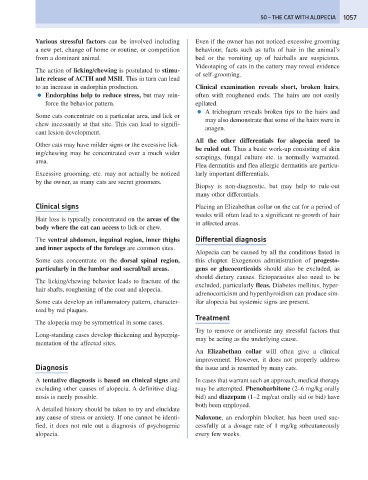Page 1065 - Problem-Based Feline Medicine
P. 1065
50 – THE CAT WITH ALOPECIA 1057
Various stressful factors can be involved including Even if the owner has not noticed excessive grooming
a new pet, change of home or routine, or competition behaviour, facts such as tufts of hair in the animal’s
from a dominant animal. bed or the vomiting up of hairballs are suspicious.
Videotaping of cats in the cattery may reveal evidence
The action of licking/chewing is postulated to stimu-
of self-grooming.
late release of ACTH and MSH. This in turn can lead
to an increase in endorphin production. Clinical examination reveals short, broken hairs,
● Endorphins help to reduce stress, but may rein- often with roughened ends. The hairs are not easily
force the behavior pattern. epilated.
● A trichogram reveals broken tips to the hairs and
Some cats concentrate on a particular area, and lick or
may also demonstrate that some of the hairs were in
chew incessantly at that site. This can lead to signifi-
anagen.
cant lesion development.
All the other differentials for alopecia need to
Other cats may have milder signs or the excessive lick-
be ruled out. Thus a basic work-up consisting of skin
ing/chewing may be concentrated over a much wider
scrapings, fungal culture etc. is normally warranted.
area.
Flea dermatitis and flea allergic dermatitis are particu-
Excessive grooming, etc. may not actually be noticed larly important differentials.
by the owner, as many cats are secret groomers.
Biopsy is non-diagnostic, but may help to rule-out
many other differentials.
Clinical signs Placing an Elizabethan collar on the cat for a period of
weeks will often lead to a significant re-growth of hair
Hair loss is typically concentrated on the areas of the
in affected areas.
body where the cat can access to lick or chew.
The ventral abdomen, inguinal region, inner thighs Differential diagnosis
and inner aspects of the forelegs are common sites.
Alopecia can be caused by all the conditions listed in
Some cats concentrate on the dorsal spinal region, this chapter. Exogenous administration of progesto-
particularly in the lumbar and sacral/tail areas. gens or glucocorticoids should also be excluded, as
should dietary causes. Ectoparasites also need to be
The licking/chewing behavior leads to fracture of the
excluded, particularly fleas. Diabetes mellitus, hyper-
hair shafts, roughening of the coat and alopecia.
adrenocorticism and hyperthyroidism can produce sim-
Some cats develop an inflammatory pattern, character- ilar alopecia but systemic signs are present.
ized by red plaques.
Treatment
The alopecia may be symmetrical in some cases.
Try to remove or ameliorate any stressful factors that
Long-standing cases develop thickening and hyperpig-
may be acting as the underlying cause.
mentation of the affected sites.
An Elizabethan collar will often give a clinical
improvement. However, it does not properly address
Diagnosis the issue and is resented by many cats.
A tentative diagnosis is based on clinical signs and In cases that warrant such an approach, medical therapy
excluding other causes of alopecia. A definitive diag- may be attempted. Phenobarbitone (2–6 mg/kg orally
nosis is rarely possible. bid) and diazepam (1–2 mg/cat orally sid or bid) have
both been employed.
A detailed history should be taken to try and elucidate
any cause of stress or anxiety. If one cannot be identi- Naloxone, an endorphin blocker, has been used suc-
fied, it does not rule out a diagnosis of psychogenic cessfully at a dosage rate of 1 mg/kg subcutaneously
alopecia. every few weeks.

